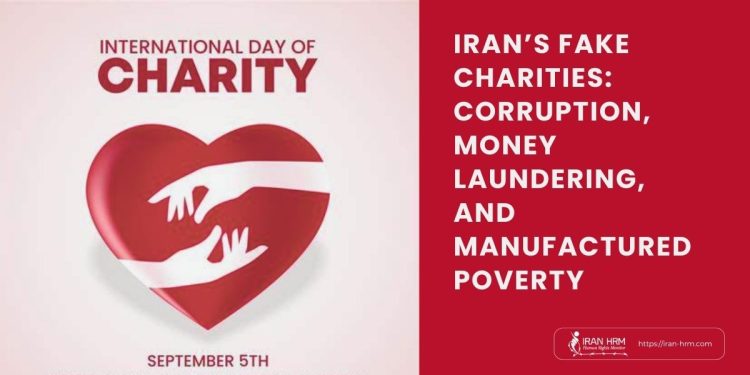Introduction
September 5, coinciding with the anniversary of Mother Teresa’s passing, has been designated by the United Nations as the International Day of Charity. The philosophy of this day is to honor solidarity and the global fight against poverty, serving as a reminder of human dignity and the crucial role of voluntary assistance in charities in improving the lives of the most vulnerable.
In Iran under the rule of the mullahs, however, this day carries an entirely opposite meaning. Institutions operating under the name of charity – such as the Foundation of the Oppressed (Bonyad Mostazafan), Astan Quds Razavi, and the Khomeini Relief Committee – have become centers of corruption, money laundering, and the reproduction of poverty. Poor families and child laborers, who should be the first to benefit from support, are instead trapped in a vicious cycle of dependency and deprivation.
Foundation of the Oppressed: An Economic Giant Behind the Mask of Charity
The Foundation of the Oppressed was established after the 1979 revolution under the banner of helping the poor. Its first chairman, Mohsen Rafighdoost, a commander of the Revolutionary Guards, turned it from the outset into an economic arm of political power. Today, the foundation is the second largest economic conglomerate in Iran after the National Oil Company, owning over 160 companies in oil and gas, mining, construction, banking, insurance, and tourism.
The foundation is run directly under the authority of the regime’s highest figure, Ali Khamenei, and is exempt from independent oversight. This structure has turned it into one of the principal centers of corruption and rent-seeking.
Even officials of the regime have admitted to corruption:
• Parviz Fattah, former head of the foundation: “In Noor Foundation, one of the subsidiaries of the Foundation of the Oppressed, about 123 billion tomans were embezzled.”
• Ali Khezrian, a member of parliament (2024): “Hotels under the management of the Foundation of the Oppressed worth nearly 95 trillion tomans were transferred at low prices to specific individuals.”
An institution that was meant to serve as a source of assistance to the poor has in reality become a tool for systematic plunder, charity in name, but in practice a machine of wealth accumulation for the ruling elite.
Astan Quds: The Regime’s Tool for Building a Financial Empire
Astan Quds Razavi, custodian of the shrine of Imam Reza in Mashhad, is another massive religious–economic institution in Iran, run directly under Ali Khamenei and exempt from taxation. Its wealth is estimated in the tens of billions of dollars.
This institution, which should dedicate its revenues to pilgrims and the needy, has instead been turned into an economic empire.
• Mehdi Azizian, former deputy of Astan Quds, was forced to flee the country due to the exposure of his theft and massive rent-seeking.
• Domestic media have reported that a large portion of urban and rural lands in Mashhad have been registered under the name of Astan or transferred to its subsidiaries, with no transparency.
Like the Foundation of the Oppressed, Astan Quds exploits the name of “charity” merely to legitimize the plundering of public wealth, while the poor receive only crumbs.
Khomeini Relief Committee: Distributing Poverty Instead of Alleviating It
The Khomeini Relief Committee was founded with the slogan of supporting poor families and today stands as one of the regime’s largest quasi-charitable institutions, enjoying billions in public budget and substantial income from donation boxes.
In practice, however, this institution has become another site of corruption and dependency:
• Multiple embezzlement cases have surfaced in its branches, including one amounting to 12 billion tomans.
• Economic reports reveal a decline in financial transparency and the opaque use of vast revenues.
• Official statistics show that the number of beneficiaries increased by more than 60% between 2016 and 2023, meaning poverty has not decreased but deepened.
An institution that should assist the poor has instead become an instrument for controlling society’s most vulnerable, a “charity” whose survival depends on the continuation of poverty.
Link to Human Consequences
The Foundation of the Oppressed, Astan Quds, and the Relief Committee are only three prominent examples of a much wider network. The Execution of Imam Khomeini’s Order (EIKO), the Martyrs Foundation, and hundreds of other religious and pseudo-charitable institutions under the ruling regime operate on the same pattern. While claiming to “help the people,” they are in fact hubs of money laundering, embezzlement, and the distribution of poverty.
Child Laborers, Women Heads of Households, and the Cycle of Poverty
The direct outcome of these cover-up charities is the expansion of structural poverty in Iran:
• Child laborers: Their actual number is several times higher than official figures. They work in streets and dangerous workshops, deprived of education and healthcare. Instead of addressing the root causes, regime-linked charities provide only token aid, reinforcing the cycle of poverty.
• Women heads of households: More than six million women in Iran lead their families. With no sustainable support, they are forced into informal, low-paid jobs and often compelled to send their children to work, perpetuating deprivation across generations.
• Addiction and prostitution: Structural poverty drives families toward destructive social harm. Vulnerable women are pushed into dangerous activities for survival, while child laborers are exposed to drug gangs and sexual abuse.
Instead of genuine support for the poor, regime institutions reproduce this vicious cycle through meager and performative handouts.
Charity in Iran from the Perspective of International Law
Globally, charity signifies genuine assistance to the poor and social solidarity; transparent, community-driven institutions that build trust and protect human dignity. In Iran under the mullahs’ regime, however, the same concept has been hollowed out into a cover for corruption and social control. This contrast has turned the International Day of Charity in Iran into a symbol of compounded suffering for the poor.
From the standpoint of international law, the ruling regime in Iran is in blatant violation of its obligations:
• By perpetuating poverty, child labor, and the exclusion of women, it violates Articles 9 and 11 of the International Covenant on Economic, Social and Cultural Rights (ICESCR).
• By suppressing independent NGOs such as the Imam Ali Society and Khaneh Khorshid, it breaches Article 22 of the International Covenant on Civil and Political Rights (ICCPR) on freedom of association.
• By exploiting charities for money laundering and embezzlement, it stands in open conflict with Financial Action Task Force (FATF) standards.
These violations are not abstract legal breaches; they devastate millions of lives. Families trapped in extreme poverty, children whose futures are destroyed on the streets, and women forced into perilous survival strategies are the living evidence of the fraudulent nature of these so-called charities. The repression of independent organizations has also extinguished the last rays of hope for authentic assistance.
Conclusion and Call to Action
The International Day of Charity should represent solidarity and social justice. Yet in Iran under the rule of the mullahs, charity has been reduced to a tool for corruption and plunder.
We call on the UN Human Rights Council, international institutions, and civil society organizations to:
• Launch independent investigations into corruption and money laundering within Iran’s pseudo-charities,
• Pressure the ruling regime to enforce financial transparency and end unjust exemptions,
• And support independent NGOs and human rights defenders so the voices of Iran’s poor are not silenced.







